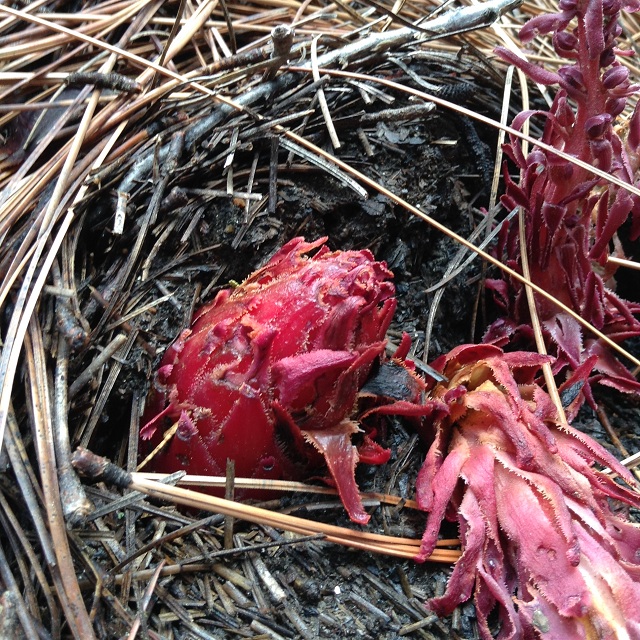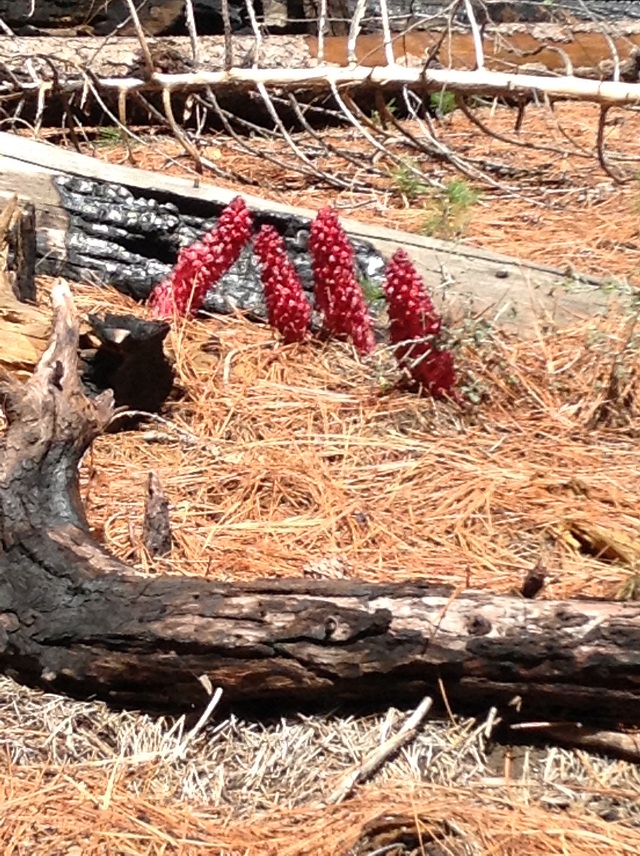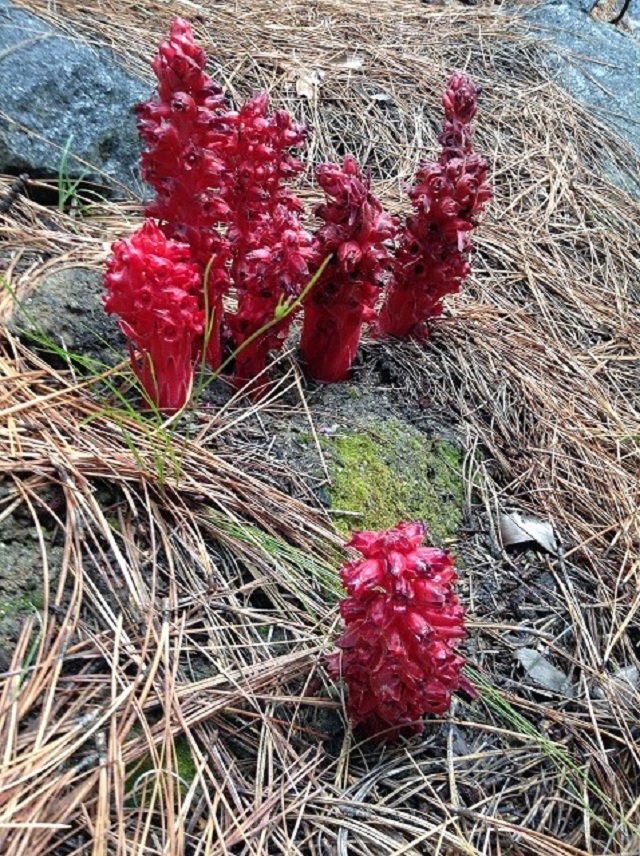
Rare Snow Plant in Yosemite West
Friends I greet you from Yosemite
The snow plant is rare and is protected by law. There is a heavy fine for picking or otherwise disturbing any one of these rare beauties.The snow plant (Sarcodes sanguinea) is more admired by tourists than any other plant in California. It is red, fleshy, and watery; and looks like a giganitic asparagus shoot. The snow plant is of great interest to flower enthusiasts and photographers at all stages of its development because of its deep striking red color....very dramatic!!! I was thrilled to come across a few multiple groupings of snow plants on May 16, 2015, while hiking in Yosemite West. They are unusual, indeed. They are rare beauties, indeed.
I hope you enjoy the snapshots...a group of snow plants with one snow plant nearby....separated by some moss a snow plant as it emerges from the humus a group of 4 snow plants against a burnt log in the forest snow plant's beautiful rosy flower...closeup Snow Plant... gets its common name....because it emerges early in the spring, just after (and occasionally during) snowmelt.
- Sarcodes derives from the Greek word sarkodes, which means "resembling flesh".
- Sanguinea is a Latin term meaning "blood-red".
- The plant has a vivid red color, indeed.
The snow plant lacks chlorophyll and, therefore, cannot make its own food by photosynthesis. It was once classified as a saprophyte receiving its nourishment from decaying organic material under the forest floor. Through the help of fungi growing in its roots, decaying organic material in the soil is broken down for food. Botanists now say...the snow plant's symbiosis with underground mycorrhizal fungi....AND these same fungi's symbiosis with pine trees.......explains everything !!! ..... For now!!! maybe its both methods!!!....I wonder.

These fungi live in the humus layer of forest soil. Mycorrhizal fungi are composed of strands of cells (mycelia) that grow about in the soil; these strands are quite numerous and extensive. These fungi also grow in the roots of a snow plant. The fungi are also attached to roots of pine trees....the tree provides fixed carbon to the fungi, and in return, the fungi provide mineral nutrients, water, and protection from pathogens to the tree.
The snow plant takes advantage of this symbiosis between the tree and the fungi...... and by way of the fungi......gets sugar from the tree!!! Networking!!! The snow plant once belonged to the Wintergreen Family.....now it belongs to... the Indian-pipe Family....a relative of the Heath Family....where it once belonged also...ask a botanist.
- The stems are unbranched, thick, and red.
- The leaves are scalelike and ciliate (with a line of hairs along the margins).
- The flowers are many in stout spicate (spikelike) racemes.
- The stalks are edible when cooked like asparagus.
- The plant grows between 6 to 2 inches in height.
- It live in areas of deep forest humus.
Some definitions....
- Symbiosis...the living together of 2 kinds of of organisms to their mutual advantage.
- Saprophyte...getting its nourishment from dead or decaying organic material.
- Bracts...a rudimentary leaf subtending a flower.
- Scale...a small membranous bract.
- Racemes...an inflorescence with one main axis and subequal primary branches (pedicels) each bearing one flower.
- Inflorescence......the cluster of flowers on a plant.
- Humus...the dark part of the soil, resulting from the partial decay of leaves, etc.
Humble...lowly
Initially, the plant has long fingerlike twisting scales wrapping the plant... as the plant matures, the scales loosen and separate.... revealing nodding, delicate, urn-shaped blossoms 1/2 to 3/4 inches long. The snow plant reaches it final blooming phase in about 3 weeks.....after it first begins to emerge through the forest floor in early May, emerging later, of course, at higher elevations ...all dependent on the yearly snow pack....usually growing season is from April to July... Aat 4000 to 8000 feet. The snow plant grows in Yosemite Valley, Crane Flat, Yosemite West, Chinquapin, along the Glacier Point Road, in the red fir forests of the Glacier Point area, and in the Mariposa Grove.

Observations on the snow plant.....from The Yosemite by John Muir
"Soon after the snow is off the ground it rises through the dead needles and humus in the pine and fir woods like a bright glowing pillar of fire. In a week or so it grows to a height of eight or twelve inches with a diameter of an inch and a half or two inches; then its long fringed bracts curl aside, allowing the twenty or thirty-five lobed, bell-shaped flowers to open and look straight out from the axis. It is said to grow up through the snow; on the contrary, it always waits until the ground is warm, though with other early flowers it is occasionally buried or half-buried for a day or two by spring storms.
The entire plant....flowers, bracts, stem, scales, and roots....is fiery red.. Its color should appeal to one's blood. Nevertheless, it is a singularly cold and unsympathetic plant. everyone admires it as a wonderful curiosity, but nobody loves it as lilies, violets, roses, daisies are loved. Without fragrance, it stands beneath the pines and firs lonely and silent, as if unacquainted with any other plant in the world; never moving in the wildest storms; rigid as if lifeless, though covered with beautiful rosy flowers."
My humble observations......
- Is the snow plant pollinated by the hummingbird?
- The snow plant is definitely not humdrum in color.
- Indeed, seeing the snow plant made me hum...
- The snow plant lives on the forest floor humbly rooted in the thick layer of humus.
Get a good night's rest in a beautiful Scenic Wonder vacation home ....before you venture out to see the beautiful plants growing along Yosemite's trails....and be prepared to be thrilled when you spot your first rare snow plant. Bring the family and a camera.
Another terrific day in Yosemite









